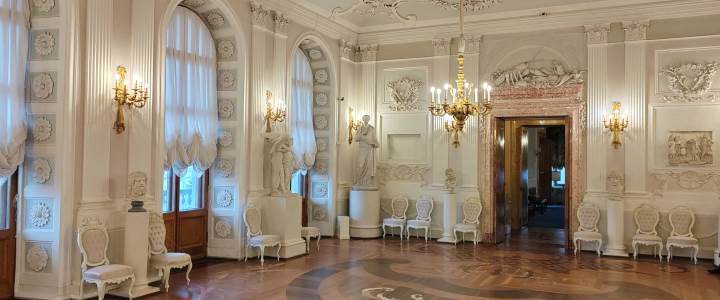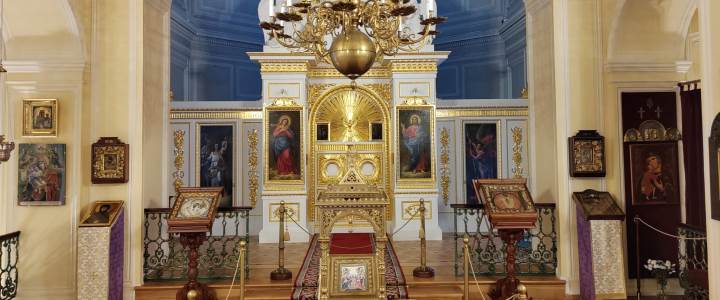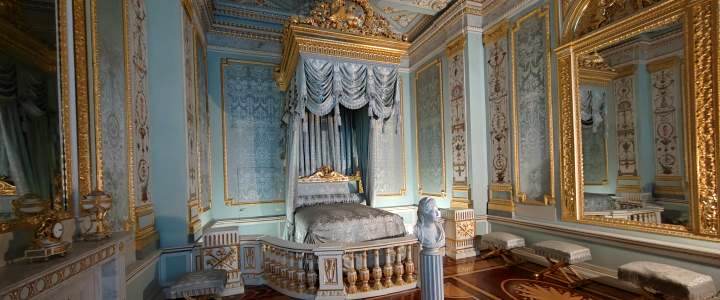The palace and park at Gatchina dates back to the time of Empress Catherine II. In 1765, the tsarina gave her favourite, Count Grigory Orlov, a lavish gift – the Gatchina estate. The picturesque landscape, spring-fed lakes with connecting tributaries and rivers made it possible to create here the unique landscape park with the palace of remarkable architecture as its focal point.
The design for the palace was developed by the Italian architect Antonio Rinaldi; construction began on May 30, 1766.
According to the contemporary records, the Empress and her suite visited Gatchina several times to inspect the construction. The building works were completed by 1781. The palace that emerged as a result looked like an Italian palazzo with facades faced with natural stone, Pudost limestone.
The three-storied Central building with flanking pentagonal towers is connected with semicircular galleries to the one-storied service wings, rectangular in plan with inner courtyards. “The furnishings of the castle are splendid, and the apartments on the upper floor house a fine collection of Italian painting”, wrote the French diplomat Corberon following his visit to Gatchina. Along with the palace, an English landscape park was laid out, among the first of the kind in Russia.
The brilliant nobleman Grigory Orlov was not destined to live in the new estate as he died in early 1783. The empress Catherine II bought back the estate from the count’s heirs and on August 6 of the same year presented it to her son, the Grand Duke Paul Petrovich. Shortly thereafter Gatchina was to become his favourite residence.
The palace was altered somewhat under the architect Vincenzo Brenna. In keeping with the pace of fashions, the state rooms were remodelled, formal gardens, park pavilions, stone gates and bridges emerged. Following the ascension of Paul I to the throne in 1796, Gatchina became the imperial residence that the contemporaries referred to as an impregnable fortress with surrounding ramparts, moats, sentry boxes and barriers.
The Emperor Paul I was assassinated in a coup at the Mikhailovsky Castle on March 12, 1801. After his death the Dowager empress Maria Feodorvna came to own the Gatchina estate. On January 21, 1827, she bequeathed the Gatchina estate with the adjacent lands “for permanent ownership” to the Emperor Nicholas I and his line of male hairs.
In the reign of Nicholas I, the Palace underwent a major reconstruction and acquired its present-day look. The Kitchen and Arsenal Wings were dismantled completely and then erected anew as they did not meet modern criteria of comfort. In keeping with the fashion of the time, the Arsenal Wing was designed to accommodate both the private and state rooms for the Imperial family.
In the Kitchen Wing, the chapel was completely rebuilt. To keep the memory of Paul I, his private rooms and the 18th-century state apartments in the Central building were carefully preserved, although it did undergo some alterations, namely, heating was replaced, parquet floors repaired, new pieces of furniture, sculptures and drapery were introduced in some of the halls. All the stages of reconstruction were carried out under the direction of the architect R.I.Kuzmin from 1844-1856.
Nicholas I and his son Alexander II seldom visited Gatchina. They came here mostly to attend balls, receptions for crowned heads and important noblemen, or to participate in imperial hunts.
The Emperor Alexander II was mortally wounded on the Catherine embankment (now Griboedov canal) on March 1, 1881. He was succeeded by his son, Alexander III, who chose Gatchina as his principal residence. On March 27, the tsar’s family moved to the Gatchina Palace, which remained their beloved home for many years.
In May 1917, the Provisional Government issued a decree on the establishment of artistic and historical commissions in the towns of Peterhof, Tsarskoye Selo and Gatchina for the purpose of “acquisition, recording and inventorying the movable and immovable property of the former palaces”. One year later, on May 19, 1918, the Gatchina Palace opened to the public.
The Palace and its parks suffered significant damage during World War II. Restoration work began as late as 1976. The first 18th-century state rooms were opened to the public in 1985, including the Anteroom, the Marble Dining Room, Paul’s Throne Room and the exhibition installed on the second floor of the Central Building.


